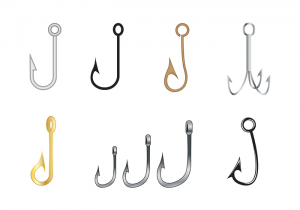 Back at the dawn of humankind, anglers everywhere were frustrated by their inability to catch the multitude of fish they could see in the water all around them.
Back at the dawn of humankind, anglers everywhere were frustrated by their inability to catch the multitude of fish they could see in the water all around them.
Countless hours were spent throwing braided pieces of grass into the water, then retrieving them, without any luck at all.
Then an enterprising young man named Oothach came up with the idea of attaching a pointed object to the end of the braided grass to snag a fish on the retrieve. His friends expanded on this idea by putting edible little bits onto these pointed snags, and thus the idea of a fishing hook was born.
Today, the fishing hook, along with mankind, has evolved in leaps and bounds, with several hundred styles, shapes, sizes, and materials. Fishing hooks have developed that are tailored to specific species, salmon included. Fishing hooks for salmon are usually heavier than other species, and the hook configuration itself can be integral in the success of a day, as several species of Pacific salmon are quite soft-mouthed and the hooks need to set just right in order to have a successful catch.
Probably the most popular hook style among all salmon anglers is the treble hook. As the name suggests, these hooks have three different curves, so they give three times more opportunity for setting in the mouth of a salmon.
One disadvantage of these hooks is that as easy as they are to set, they are equally as difficult to extract. If you catch some under size salmon, it takes a long time to get the hooks all out, and the fish will often be dead or too damaged to survive once the process is over.
Straight single hooks are probably the most popular fishing hooks for salmon among dedicated anglers. These hooks set in a cleaner fashion than the trebles, and they will also hold a salmon more securely. The hook is curved straight back up, parallel to the shank, which is probably the reason they set so nicely. This type of hook is ideal when angling with lures like spoons and plugs.
If you are interested in tying your own salmon flies, there are hooks designed specifically for the purpose. Salmon fly hooks are always dark in color, and the eye is up turned and looped. The position of the eye helps the fly to stay upright in the water. These hooks come in a few different types; standard, low water, trebled, dry flies, and waddingtons.
Fishing hooks for salmon that are used in salt water should always be made from stainless steel; in fact, all of your hooks should be made from this material. Hooks made from other materials are notorious when it comes to rusting, and rust will make a big mess not only of your hook itself but also of your tackle box. Buying hooks made with this material will save you a lot of grief and expense.

